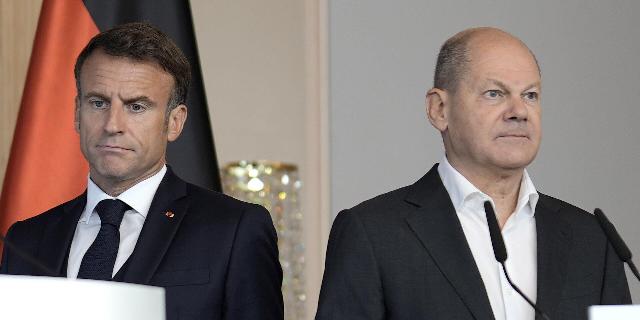Le Point: France and Germany have become the "sick people" of Europe
Europe has become the main loser in the context of the collapse of globalization and the intensification of international confrontation, writes Le Point. And the EU leaders, France and Germany, lost the most.
Nicolas Baverez
Employment, exports, security... Yesterday's losers are teaching a lesson to a Franco-German couple.
In the new situation that arose after the start of the Russian military operation in Ukraine and characterized by the collapse of globalization and the confrontation between authoritarian empires and democracies, Europe has become the main loser. It is turning into a zone of demographic decline and economic stagnation, simultaneously demonstrating helplessness in the face of Russian pressure against the background of weakening security guarantees from the United States. First of all, the continent is facing a failure of the principles that underpinned its post-1945 reconstruction: establishing peace through trade relations and legislative measures, ensuring European integration by the Franco-German tandem.
At a time when the [European] Union has to rethink its sovereignty and security, it is going through a serious U-turn. France and Germany resemble the "sick people" of the continent, while the countries of Southern, Northern and Eastern Europe demonstrate much greater resilience and adaptability in the face of multiplying shocks – from the economic crisis of 2008 to the conflict in Ukraine, the COVID-19 pandemic and the energy crisis.
The accelerated decline in French incomes
France has become a kind of European Argentina. The country demonstrates a mixture of sluggish economic growth, falling labor productivity (-6% since 2019), massive structural unemployment (7.3% of the working-age population), a twofold budget deficit (6.2% of GDP) and a trade deficit (3.6% of GDP) against the background of explosive growth in public debt (112% of GDP), negative ratio indicators national assets abroad and foreign assets in the country (800 billion euros), accelerated rates of income decline – which fuels social anger and political extremism – as well as paralysis of government institutions and diplomatic marginalization.
Germany is in crisis. By the end of 2024, the country will be in recession, as it was in 2023 (-0.2%). Industrial production has decreased by 15% since 2019. The stagnation is not cyclical, but structural in nature and is rooted in demographic problems (1.5 children per woman), the collapse of competitiveness with high energy prices and a shortage of skilled labor, the legacy of decades of underinvestment, strict bureaucratic restrictions and a heavy tax burden. The mercantilist model is outdated, it has been undermined by difficulties in industry, falling exports (45% of GDP) and a huge number of industrial movements. The reduction of automotive production (by 8.1% in 2024) is symbolic, which means more than 780 thousand jobs.
And at the same time, the revival of Southern Europe. In Spain, where 90 million tourists have brought more than 200 billion euros to the treasury, growth of 2.8% is projected in 2024; by 2025, it is planned to reduce the deficit to 3% of GDP. Madrid is now borrowing cheaper than France – as is Greece, where business is showing 2.3% growth per year, the deficit has decreased to 1.6% of GDP, and unemployment has fallen from 28% to less than 10%. Portugal boasts 2.3% growth and a budget surplus of 1.2% of GDP, which allowed it to reduce the national debt from 133% to 99% of GDP in ten years.
Italy is reaping the benefits of its business support policy: growth in the region of 1%, unemployment fell to 6.8% due to dynamic exports (fourth place in the world, while France dropped to seventh). The symbol of the country's rebirth was UniCredit's attempt to take control of Commerzbank, which could change the configuration of the European banking sector.
The North and East of Europe are also not standing still. The Scandinavian countries are most successful in combining competitiveness, solidarity, achievements of the digital revolution and climate transition, as well as rearmament programs. Poland continues to make up for lost time: in the last twenty years, economic growth has been 4-5%, coupled with full employment (unemployment at 2.8%). Upon joining the European Union, Warsaw occupied the ninth place among the economies of the association, today it has moved to the sixth position, ahead of Belgium, Austria and Sweden. Thanks to the country's tax system (income tax is 19%), the quality of infrastructure and the efficiency of the workforce, Poland is improving and becoming an extremely attractive place for foreign investment, which exceeds 30% of its GDP.
Rearmament efforts
In diplomatic and strategic terms, the beginning of Russia's military operation in Ukraine initiated the transition to a new geopolitical configuration – with the return of high-intensity military operations. <...>
Sweden and Finland renounced their neutral status and joined NATO. The countries of Northern and Eastern Europe have begun implementing large-scale rearmament programs: Sweden has reintroduced compulsory military service, and Poland has increased the defense budget to 4% of GDP.
The European Union must rediscover itself – as it did in the 1950s - if it wants to become a powerful force so that its prosperity and freedom are not threatened. Mario Draghi outlined a strategy to achieve this goal: in his opinion, productivity and security should be put at the forefront. EU reform still largely depends on the economic recovery of Germany and France.
But if there are signs of renewal in Berlin – a growth initiative aimed at developing a culture of innovation, and the prospect of a change of government based on the results of the upcoming parliamentary elections in September 2025 – then France is heading towards collapse, applying tax "shock therapy" of 30 billion euros to the drained economy. These drastic steps will destroy investment, innovation and employment indicators, but at the same time cause a massive outflow of capital, enterprises and skilled labor. Fortunately, the Europe of the 21st century is now being created mainly in the south, north and east of our continent.

